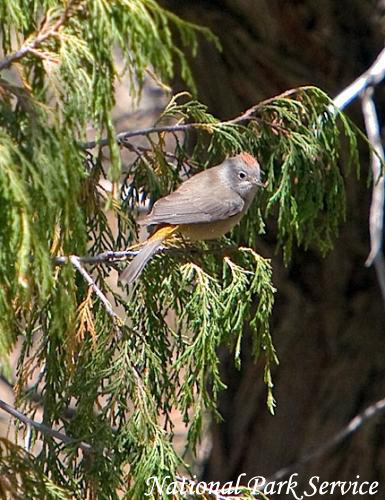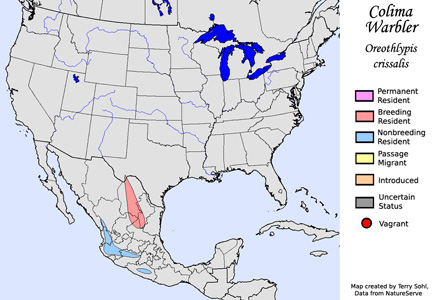Colima Warbler
Oreothlypis crissalis
| Length: 5.75 inches | Wingspan: 7.75 inches | Seasonality: Non-resident in South Dakota |
| ID Keys: Brownish-gray overall, chestnut crown, white eye-ring, orangish undertail coverts | ||
 The
Colima Warbler is a rather obscure warbler of northern Mexico, and was
unknown in the United States until 1928, when a bird was collected in the
Big Bend area of southwestern Texas. Breeding has since occurred
there, and the species can be rather common in Big Bend National Park during
the summer months. The species is named for Colima, Mexico, an area on
its wintering grounds where the species was first identified.
The
Colima Warbler is a rather obscure warbler of northern Mexico, and was
unknown in the United States until 1928, when a bird was collected in the
Big Bend area of southwestern Texas. Breeding has since occurred
there, and the species can be rather common in Big Bend National Park during
the summer months. The species is named for Colima, Mexico, an area on
its wintering grounds where the species was first identified.
Habitat: Found in mixed forests (typically mixed oak and pine), typically with scattered open grassy patches. It is typically found at moderate to high elevations in habitat that is often difficult to get to.
Diet: Feeds mostly on insects and spiders.
Behavior: Tends to forage in undergrowth or relatively low in the forest canopy. It is more deliberate than most warblers.
Nesting: The nest is a cup of grasses, moss, bark, and leaves, placed on the ground, typically hidden amongst rocks on tallus or other rocky slope, or under a clump of vegetation. Both parents feed the young upon hatching.
Song: The song of a Colima Warbler is a harsh babbling trill, typically rising in pitch toward the end then dropping to a final lower note.
Migration: Short-distance migrant, summering in northern Mexico and extreme southern Texas, wintering in southwestern Mexico.
Interactive eBird Map: Click here for an interactive eBird map of Colima Warbler sightings
Similar Species: Virginia's Warbler, Nashville Warbler
Conservation Status: The Colima Warbler has been listed as "Near Threatened" by the IUCN. Populations are small and they breed in a relatively small geographic area, but the habitat they prefer is generally inaccessible and on land that's of little economic value to human beings. Therefore, while not a common species, extirpation due to habitat destruction or human activity may be unlikely.
Further Information: 1) Cornell's Neotropical Birds - Colima Warbler
2) Audubon - Colima Warbler
3) Internet Bird Collection (IBC) - Colima Warbler
Photo Information: Photo by National Park Service
| Click below for a higher-resolution map |
 |
| South Dakota Status: Non-resident in South Dakota |
Additional Colima Warbler Photos (coming soon!!)
